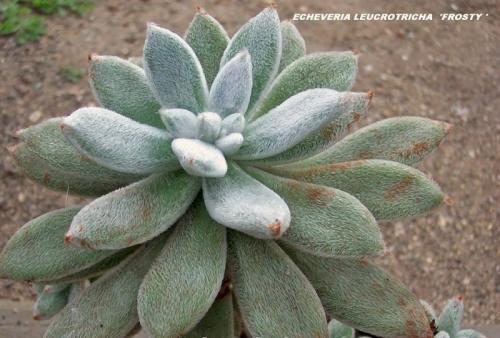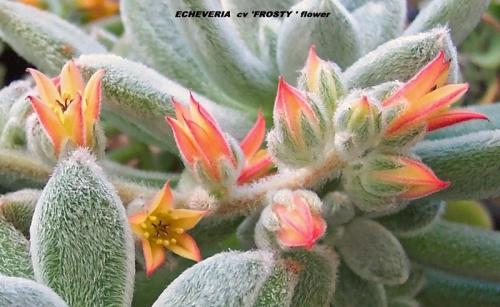LEUCOTRICHA Purpus, 1914
Series Echeveria
Type : J.A. Purpus, s.n., on rocks in the mountains near San Luis Tultitlanapa (now San Luis Atolotitlan) in the Sierra de Mixteca, Puebla, Mexico, summer 1908.
Etymology : Gr. 'leukos' = white, and 'trichos' = hair. For the white hairs covering the plant.
Distribution: Mexico (southern Puebla : Vicinity of San Luis Atolotitlan ; Cerro del Castillo, Caltepec).
First Description by J.A. Purpus in Monatsschrift für Kakteenkunde 24: 65. 1914 :
Caulescens ramosa, caule et ramulis dense pube vulpino-brunnea tectis. Folia laxe rosulata, oblonga, elliptica, lanceolata, obtusa acutata, 6-8 cm longa, 2-2,5 cm lata, crasse carnosa, supra subconcava, subtus convexa, pilis albidis mollibus tomentosa, apice vulpino-brunnea. Inflorescentiae axillares, laxe foliatae, ca. 30-40 cm longae; flores sessiles, in racemum simplicem serius laxum dispositi, bracteis tribus calyci appressis carnosulis fulti, sepala 5, usque basin libera, lanceolata, carnosa, 1 cm longa, 2 cm lata, albido-tomentosa; petala 5, usque basin libera, patentia, lineari-lanceolata, tenuiter acuminata, apice reflexa, carnosa, dorso carinata, intus sulcata, cinnabarina, 1,8-2 cm longa, 3 mm lata; filamenta albida, antherae luteae, stylos paullo superantes; ovarium 5-carpellatum albidum; styli 5 breves, apice brunneoli stigmatibus nitidulis lateralibus.
Stammbildend. Verzweigt.
Stamm und Zweige dicht mit fuchsbraunem Haarfilz bekleidet.
Blätter rosettig, locker gestellt, oblong, elliptisch, lanzettlich, stumpfspitzig, 6—8 cm lang, 2—2,5 cm breit, dickfleischig, oberseits etwas konkav, unterseits konvex, dicht mit ca. 2 mm langen, weissen, derben, weichen Haaren filzartig bedeckt, an der Spitze fuchsbraun.
Blütenstände seitlich in den Blattachseln der Rosette, sich bis ca. 30-40 cm verlängernd, locker beblättert; Blätter kürzer und schmäler als die Rosettenblätter, mehr zylindrisch und ebenfalls dicht mit weissem Haarfilz bekleidet, an der Spitze fuchsbraun.
Blüten sitzend in einfacher, anfangs dichtblütiger, kurzer, später sich verlängernder, lockerblütigen Traube; sie sind von drei dicht dem Kelch anliegenden, fleischigen Hochblättern gestützt; das mittlere Stützblatt grösser, so lang wie der Kelch, die beiden seitlichen kleiner, viel kürzer als der Kelch.
Kelchblätter 5, bis zum Grunde frei, lanzettlich zugespitzt, fleischig, dick, 1 cm lang, 2 mm breit, wie die Hochblätter dicht weissfilzig behaart, an der Spitze mit fuchsbraunem Haarbüschel; Blüte glockig, Krone spreizend.
Kronenblätter 5, bis zum Grunde frei, lineallanzettlich, in eine feine Spitze auslaufend, oben zurückgekrümmt, fleischig, auf dem Rücken scharf gekielt, innen tiefrinnig, im Durchschnitt dreieckig, zinnoberrot, in der Mitte am Kiel dunkler, innen und nach dem Rande zu heller, auf der Rückseite mit fleischigen Drüsenhaaren besetzt, 1,8-2 cm lang, 3 mm breit.
Fruchtknoten 5-blätterig, weiss, Staubfäden weiss, Staubbeutel gelb, nur wenig die Griffel überragend. Griffel 5, kurz, oben bränlich, mit glasigen, glänzenden, seitlich stehenden Narben.
Von der sehr nahe verwandten Echeveria pulvinata Rose unterscheidet sich E. leucotricha hinreichend, um sie als eigene Art aufzustellen. Die Blätter der E. pulvinata sind viel breiter und weniger dicht behaart, die Blüten gestielt, im Grundton orangegelb, aussen zinnoberorangerot, die Kronenblätter doppelt so breit, bis oberhalb des Grundes verwachsen. Kiel in ein feines Spitzchen verlaufend, das unterhalb der Spitze der Kronenblätter endigt; auch die Blüte ist in der Form anders. Die Krone weniger spreizend und zurückgebogen.
Die prachtvolle, durch ihre dichte, schneeweisse Behaarung aller Teile sehr auffallende und charakteristische Art fand J. A. PURPUS an Felsen in den Bergen bei San Luis Tultitlanapa in der Sierra de Mixteca im Staate Puebla, Mexiko, im Sommer 1908. Sie ist eine der schönsten, eigenartigsten mir bekannten Echeverien und überbietet die hübsche E. pulvinata bei weitem an Schönheit, namentlich auch der Blüten.
Cytology : n = 38.
Note :
While in 1914 J.A. Purpus considered E. leucotricha to be sufficiently distinct and different from E. pulvinata to deserve species rank, in 2017 M. Kimnach reclassified it as a variety of the latter (see Cactus and Succulent Journal US 89(1): 11. 2017). In view of the very different chromosome numbers of the two species - E. leucotricha n = 38, E. pulvinata n = 23 - Kimnach's reclassification is not comprehensible.
Walther's description of E. leucotricha is made from plants of unknown origin, therefore is of no use.
Plants in cultivation :
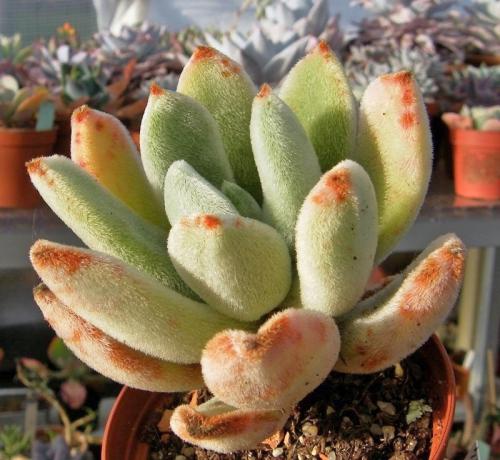
Photo Emmanuelle Aubé
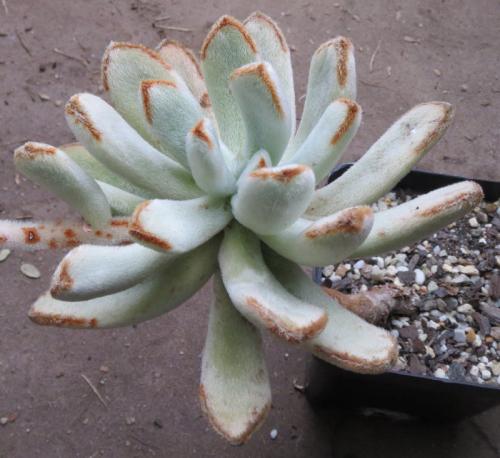
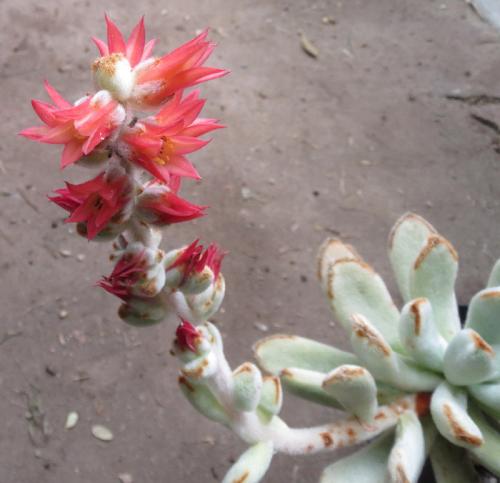
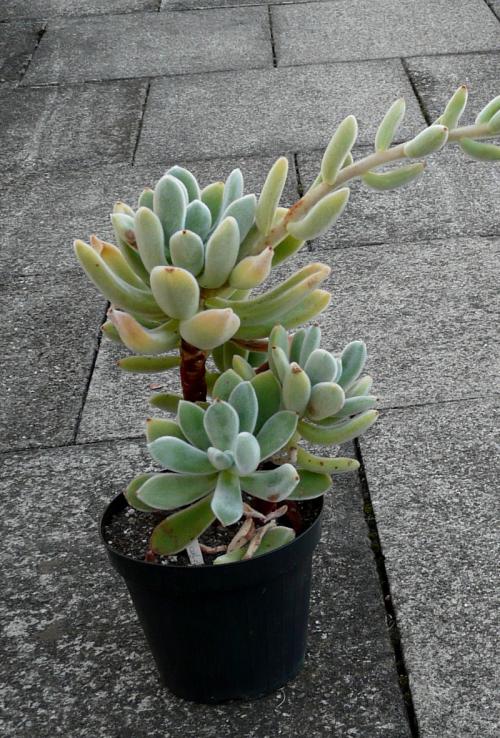
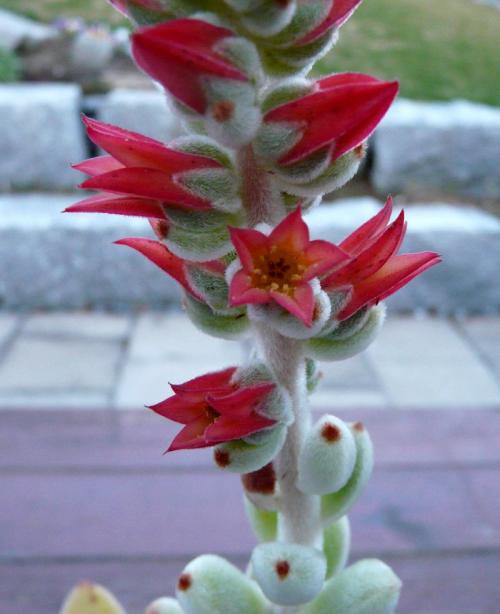
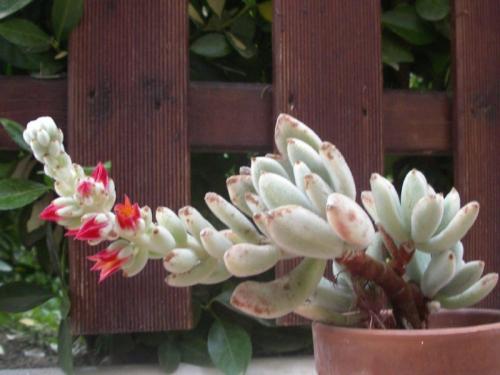
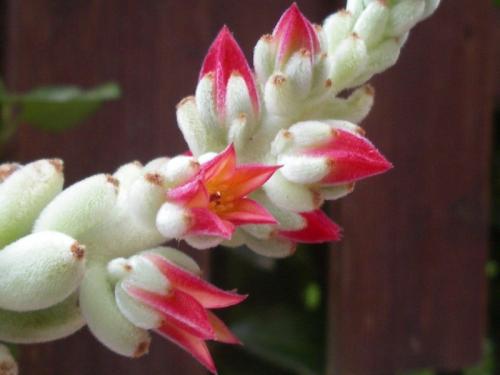
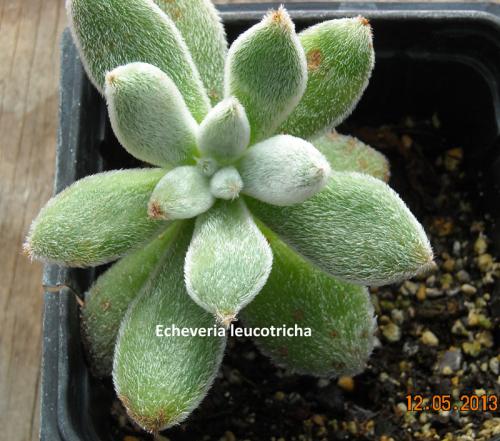
There is a cultivar called E. leucotricha 'Frosty', named by Dick Wright. It is interesting
1. that the preceding photo by Dick Wright of the species E. leucotricha corresponds with Bev Spiller's photo (below) of the cultivar E. leucotricha 'Frosty', which she had received from DW with this name;
2. that the inflorescence of Dick Wright' E. leucotricha 'Frosty' (photo below) is wrong for E. leucotricha, the pedicels are far too long and also the flower colour is dubious;
3. that the flower colour of Bev Spiller's photo of this alleged cultivar is also dubious while on the other hand the shape of the inflorescence of her plant is correct for E. leucotricha.
If Dick Wright's inflorescence is correct, his "Frosty" is not a leucotricha cultivar but a hybrid. And this would mean that Bev Spiller's plant is not 'Frosty' but "only" the species with too pale flowers, possibly due to cultivation conditions.
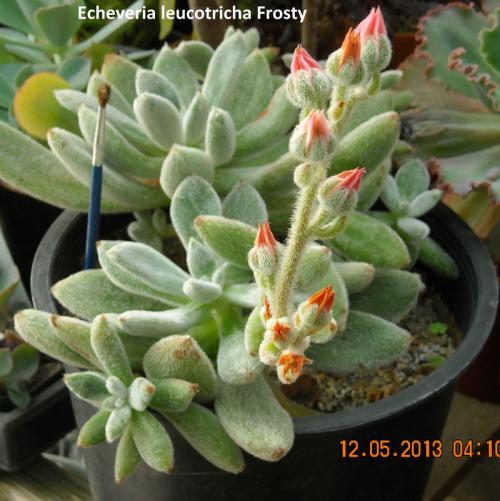
Photos Dick Wright
